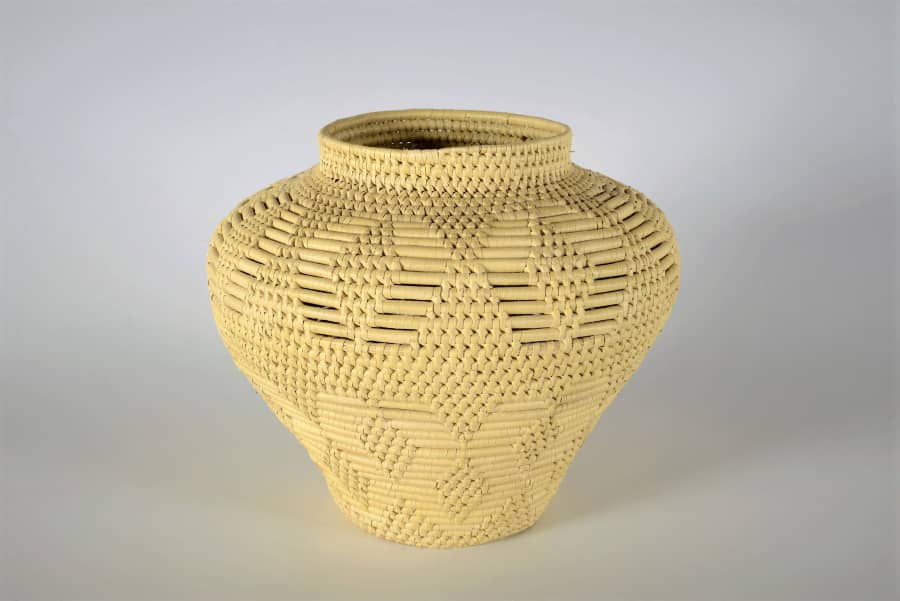Description
Entre las manifestaciones artesanales de gran arraigo en Cuba, se encuentra la cestería, nombre que se designan los trabajos de tejidos de fibra vegetal con los que se elaboran diversos objetos, como el tradicional sombrero campesino de yarey, los canastos para la recogida de frutos, las nasas de pescar y una gran variedad de artículos: canastilleros, costureros, centros de mesa, muebles pamelas, sandalias, carteras, etc. También se confeccionan juguetes y máscaras asociadas a festividades como el San Juan.
Existe una gran diversidad de fibras, siendo el yarey una de la más extendidas sobre todo en la región centro oriental. También se trabajan la caña de castilla, el tibisí, el macusey, la yagua, el coco, el maíz, la anacagüita, los juncos, la malangueta, el guaniquiqui, el mimbre, el henequén, el plátano, entre otras. Algunas de estas especies son oriundas de Cuba, como el yuraguano de hojas casi circulares y la palma real. La mayoría se localiza de manera silvestre junto a ríos y arroyos, en terrenos llanos o en zonas montañosas. Hay especies que son propias de determinadas regiones como la anacahuita de Guantánamo, la provincia más oriental del país.
El grado de durabilidad y flexibilidad de una fibra, así como sus cualidades de color y textura constituyen elementos muy altamente valorados para la fabricación de objetos artesanales. Las partes de las plantas más utilizadas son las hojas, las cortezas y vaina foliar que en las palmas es un tejido que permanece en el tallo al caer la hoja. Por lo general, trabajan el color de la fibra natural, aunque también combinan la fibra natural con fibras coloreadas que realzan los dibujos del tejido.
Los talleres de producción son en la gran mayoría, la casa de los propios artesanos, muchos de ellos viven en zonas rurales y en algunas provincias existen talleres estatales que producen muebles y objetos de cestería como una industria local.
english
Vegetal fibers and basketry.
Among the artisanal manifestations of great roots in Cuba, there is basketry, the name that designates the works of vegetable fiber fabrics with which various objects are made, such as the traditional peasant hat of yarey, baskets for the collection of fruits, fishing pots and a wide variety of articles: baskets, baskets sewing boxes, centerpieces, hat furniture, sandals, purses, toys and masks associated with festivities such as San Juan are also made.
There is a great diversity of fibers, with yarey being one of the most widespread, especially in the central-eastern region. They also work the sugar cane, the tibisí, the macusey, the yagua, the coconut, the corn, the anacagüita, the reeds, the malangueta, the guaniquiqui, the wicker, the henequen, the plantain, among others. Some of these species are native to Cuba, such as the almost circular-leaved yuraguano and the royal palm. Most are found wild along rivers and streams, on flat terrain or in mountainous areas. There are species that are native to certain regions, such as the anacahuita of Guantánamo, the easternmost province of the country.
The degree of durability and flexibility of a fiber, as well as its color and texture qualities, are highly valued elements for the manufacture of handmade objects. The most commonly used parts of the plants are the leaves, bark and leaf sheath, which in the palms is a tissue that remains on the stem when the leaf falls. They usually work with the color of the natural fiber, although they also combine the natural fiber with colored fibers that enhance the patterns of the fabric.
The production workshops are mostly the homes of the artisans themselves, many of whom live in rural areas and in some provinces there are state workshops that produce furniture and basketry objects as a local industry.



Reviews
There are no reviews yet.